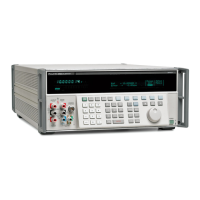5700A/5720A Series II
Operators Manual
4-54
g. Check the meter error at 1000V. See if it is within specification.
h.
Press r on the calibrator, verify that the STANDY annunciator is lit, and set
the meter function switch to 300 mV.
i.
Check the meter error at 300 mV. See if it is within specification.
6.
Test the ac voltage function:
a.
Press r on the calibrator and set the meter function switch to acV.
b.
Check the error against specifications at the following voltages and frequencies:
Voltage Frequency
2.7V 100 Hz
2.7V 500 Hz
750V 100 Hz
750V 1000 Hz
7.
Test the dc current function:
a.
Press r on the calibrator and set the meter function switch to dcI.
b.
Set the calibrator to 1.99A but do not press O yet.
c.
Press the “Currnt Output” softkey until the AUX label appears.
d.
Press O on the calibrator.
e.
Use the output adjustment controls to adjust the calibrator’s output for a reading
of +1.99 on the meter.
f.
Verify that the error shown on the control display is within specification.
g.
Set the meter function switch to 300 mA, move the current lead to the 300 mA
terminal, and check the error at 27 mA and 200 mA.
8.
Test the resistance function:
a.
Press r on the calibrator and set the meter function switch to ohms.
b.
Set the calibrator to 100Ω and press O.
c.
Press the “2 wire Comp” softkey to turn on two-wire lead-drop compensation.
d.
Use the output adjustment controls to adjust the calibrator’s output until the
reading on the Control Display is the same as the reading on the meter.
e.
Verify that the error is within specification.
f.
Repeat steps d and e for the following values, leaving two-wire compensation
turned on for 1 kΩ and 10 kΩ only:
1 kΩ, 10 kΩ, 100 kΩ, 1 MΩ, 10 MΩ
9.
Press r on the calibrator. Meter testing is complete.
4-59. Calibrating the Meter
Continue with calibration if any range was out of tolerance in the previous procedure.

